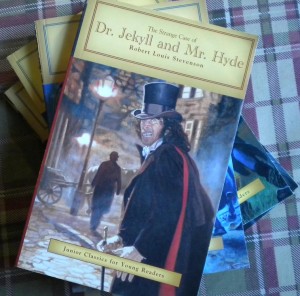
The Strange Case of Dr. Jekyll & Mr. Hyde was written by Robert Louis Stevenson, the author of Treasure Island and many more great stories, as well as some of the most popular children’s poetry.
Dr. Henry Jekyll is a good, well-respected man. Mr. Hyde is a monster — in the opening scenes of the book we learn that he trampled a little girl with complete unconcern, and later he commits a murder. And yet Mr. Hyde is actually Dr. Jekyll. Jekyll has learned to make a potion that allows his worse side to become a separate creature — Mr. Hyde. Dr. Jekyll continues to be a good doctor, but as Mr. Hyde he can do all the wicked things he wants to do. As Mr. Hyde’s behavior becomes worse, Dr. Jekyll tries to stop turning himself into Hyde. However, in the end he changes into Mr. Hyde without even taking the potion. Instead, he must take the antidote to return to his life as Dr. Jekyll. He is unable to get the special ingredients for the antidote and unable to stop turning into Mr. Hyde, so he writes out a confession of all that has happened, leaves poison ready on the table for Mr. Hyde, and waits. His friends find Mr. Hyde dead and read Dr. Jekyll’s confession with astonishment — and that is the end of the book.
There are so many good online resources for this classic that we wouldn’t take the time to create quizzes or handouts ourselves — scroll down for the links. However, we do have some cross-curricular hands-on ideas for you.
English
- The tale of Dr. Jekyll and Mr. Hyde begins with Mr. Utterson, who is usually left out of movies and retellings of the story, but whose search for the truth about his friend Dr. Jekyll takes up most of the book. The story of Frankenstein begins with Captain Walton, again just a bystander. This device of having an unimportant character lead gently into the story was popular in the 19th century. Ask students to look for other examples of this literary device, and then to think of other literary devices. For example, novels now sometimes begin with a series of emails, while books in the 20th century and earlier sometimes began with letters. Have students identify a literary device and illustrate it, creating a class bulletin board.
- Dr. Jekyll believed, as he says in Chapter 3, that he could control Mr. Hyde and be rid of him at any time. He was wrong: Mr. Hyde became more powerful than Dr. Jekyll and destroyed him. This is another similarity with Frankenstein, but it could also be said of drug use or of a bad habit like gossiping or even of unwise friendships. Ask students to write a fictional or factual account of someone’s struggle with something they thought they could easily give up — but could not.
- Use Venn diagrams to compare and contrast Frankenstein with Dr. Jekyll and Mr. Hyde.
- Read Write Think has a lesson plan with nice printables that has students create a storyboard for a transformation scene showing Dr. Jekyll becoming Mr. Hyde. I’ve had very good results with using video and other multimedia in writing classes. If you haven’t tried it, this is a well-organized lesson that will make an easy starting point.
Science
- Dr. Jekyll decides not to share his method of creating the potion that divided his good self from his evil self. This is probably because such a potion is impossible. Nowadays, we tend to think of potions in terms of magic potions created by Harry Potter and his classmates, but Stevenson was writing at a time when potions, tonics, and tinctures were taken seriously. Have students research salts (a major part of Jekyll’s potion) to determine what the potion might have included. Ask students to create recipes, giving points for plausibility and creativity, as well as for evidence of research.
- Stevenson suffered from tuberculosis and was treated with a drug derived from ergot, a hallucinogenic fungus. Read an article on Stevenson’s experience. The writer argues that Stevenson used his experiences with this drug to develop the idea of Dr. Jekyll and Mr. Hyde. See whether students agree, and then challenge them to research the effect of drugs on personality and behavior. Does their new knowledge change their opinions?
- It has been suggested that Dr. Jekyll represents the left hemisphere of the brain, which is rational and rule-governed, while Mr. Hyde is a right brain creation,with the disorderliness and originality of the right hemisphere. Does this imply that the left brain is good and the right brain evil? Have students learn more about the right and left hemispheres (resources are linked at our Brains Lesson Plans page) and draw infographics showing the characteristics that might give someone this idea.
Online resources
- Glencoe has an excellent teaching unit for the book with a lot of historical background.
- Penguin also has a teaching guide with comprehension questions for each chapter.
- SparkNotes has summaries, discussion questions, and a quiz.







